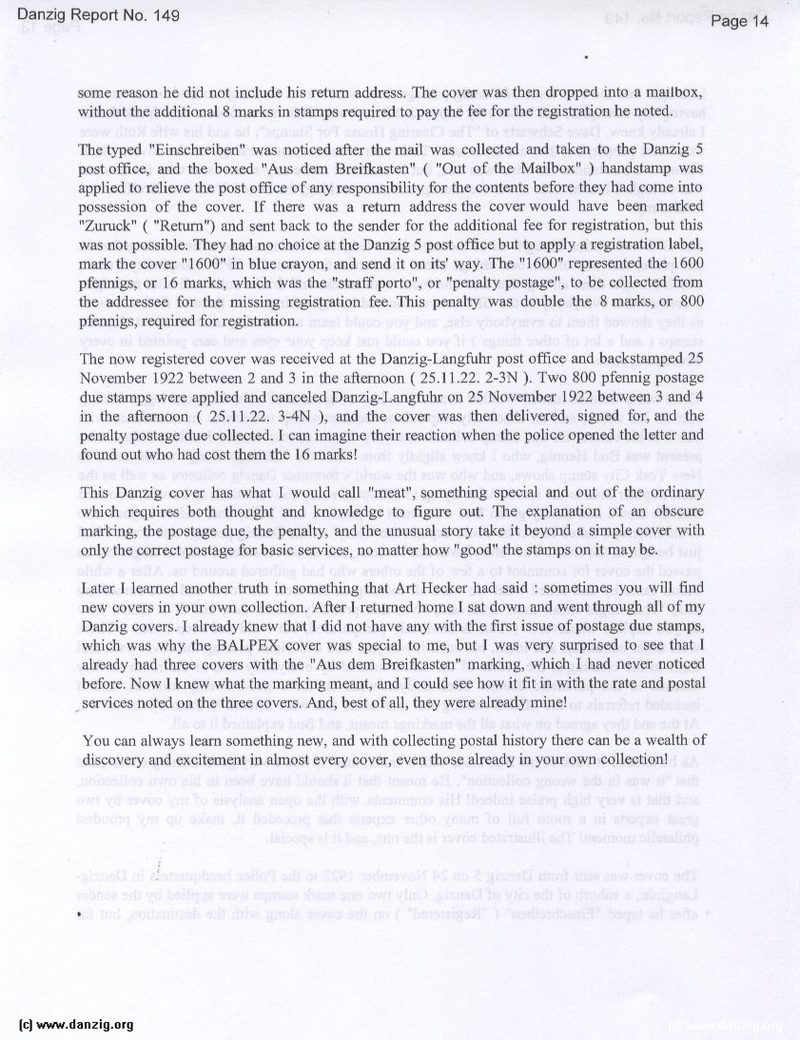
My Proudest Moment in Philately, Bill Ruh.
>> some reason he did not include his return address. The cover was then dropped into a mailbox, without the additional 8 marks in stamps required to pay the fee for the registration he had requested.
The typed "Einschreiben" was noticed after the mail was collected and taken to the Danzig 5 post office, and the boxed "Aus dem Briefkasten" (Out of the Letterbox) handstamp was applied to relieve the post office of any responsibility for the contents before they had come into possession of the cover. If there was a return address the cover would probably have been marked "Zuruck" (Return) and sent back to the sender for the additional fee for registration, but this was not possible. They had no choice at the Danzig 5 post office but to apply a registration label, mark the cover with "1600" in blue crayon, and send it on its' way. The "1600" represented the 1600 pfennigs, or 16 marks, which was the "strafporto", or "penalty postage", to be collected from the addressee for the missing registration fee. This penalty was double the 8 marks, or 800 pfennigs, required for registration.
From the Danzig 5 post office the now registered cover was transported by train to Langfuhr on 25 November, as evidenced by the marking for train number and date, 05603 – 25.11.1922, and the route, “DZG / Danzig – Langfuhr”, right below the blue crayon 1600 due marking.
The cover was received at the Danzig-Langfuhr post office and backstamped 25 November 1922 between 2 and 3 in the afternoon, 25.11.1922 2-3N. Two 800 pfennig postage due stamps were applied and canceled Danzig-Langfuhr on 25 November 1922 between 3 and 4 in the afternoon, 25.11.1922. 3-4N, and the cover was then delivered, signed for, and the penalty postage due collected. I can imagine their reaction when the police opened the letter and found out who had cost them the 16 marks!
This Danzig cover has what I would call "meat", something special and out of the ordinary which requires both thought and knowledge to figure out. The explanation of an obscure marking, the postage due, the penalty, and the unusual story take it beyond a simple cover with only the correct postage for basic services, no matter how "good" the stamps on it may be.
Later I learned another truth in something that Art Hecker had said: sometimes you will find new covers in your own collection. After I returned home I sat down and went through all of my Danzig covers. I already knew that I did not have any with the first issue of postage due stamps, which was why the BALPEX cover was special to me, but I was very surprised to see that I already had three covers with the "Aus dem Briefkasten" marking, which I had never noticed before. Now I knew what the marking meant, and I could see how it fit in with the rate and postal services noted on the three covers. And, best of all, they were already mine!
You can always learn something new, and with collecting postal history there can be a wealth of discovery and excitement in almost every cover, even those already in your own collection!
Danzig Report Nr. 149 - 2010, page 14.
Hits: 3556
Added: 21/12/2010
Copyright: 2025 Danzig.org

